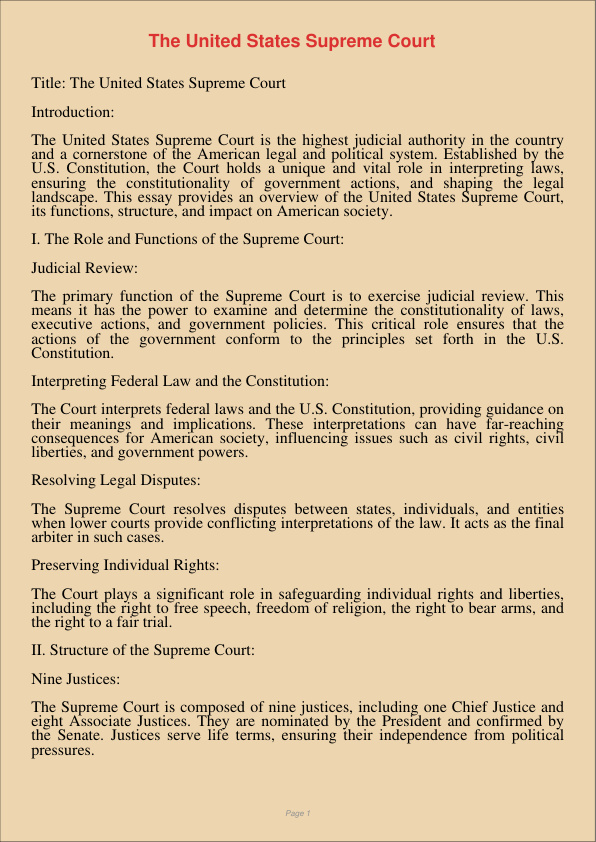Title: The United States Supreme Court
Introduction:
The United States Supreme Court is the highest judicial authority in the country and a cornerstone of the American legal and political system. Established by the U.S. Constitution, the Court holds a unique and vital role in interpreting laws, ensuring the constitutionality of government actions, and shaping the legal landscape. This essay provides an overview of the United States Supreme Court, its functions, structure, and impact on American society.
I. The Role and Functions of the Supreme Court:
Judicial Review:
The primary function of the Supreme Court is to exercise judicial review. This means it has the power to examine and determine the constitutionality of laws, executive actions, and government policies. This critical role ensures that the actions of the government conform to the principles set forth in the U.S. Constitution.
Interpreting Federal Law and the Constitution:
The Court interprets federal laws and the U.S. Constitution, providing guidance on their meanings and implications. These interpretations can have far-reaching consequences for American society, influencing issues such as civil rights, civil liberties, and government powers.
Resolving Legal Disputes:
The Supreme Court resolves disputes between states, individuals, and entities when lower courts provide conflicting interpretations of the law. It acts as the final arbiter in such cases.
Preserving Individual Rights:
The Court plays a significant role in safeguarding individual rights and liberties, including the right to free speech, freedom of religion, the right to bear arms, and the right to a fair trial.
II. Structure of the Supreme Court:
Nine Justices:
The Supreme Court is composed of nine justices, including one Chief Justice and eight Associate Justices. They are nominated by the President and confirmed by the Senate. Justices serve life terms, ensuring their independence from political pressures.
The Chief Justice:
The Chief Justice is responsible for presiding over the Court’s sessions and administrative matters. The Chief Justice’s vote holds the same weight as any other justice.
Court Sessions:
The Court typically convenes from October to June, hearing cases during its term. Cases may be initiated through the Court’s original jurisdiction or, more commonly, by appeals from lower federal and state courts.
III. Impact on American Society:
Landmark Decisions:
The Supreme Court has issued numerous landmark decisions throughout its history. These decisions have shaped American society in areas such as civil rights (Brown v. Board of Education), privacy rights (Roe v. Wade), and presidential power (United States v. Nixon).
Legal Precedent:
Supreme Court rulings set legal precedents that lower courts must follow. These precedents influence legal interpretation, ensuring consistency in the application of law.
Checks and Balances:
The Court serves as a vital check on the power of the other branches of government (the executive and legislative branches). It ensures that laws and policies are consistent with the Constitution and that individual rights are protected.
Conclusion:
The United States Supreme Court is a foundational institution that plays a pivotal role in the American legal and political system. Its functions, structure, and impact on American society underscore its significance in upholding the rule of law, preserving individual rights, and maintaining the delicate balance of power among the branches of government. The Court’s decisions have far-reaching consequences, making it a crucial institution in shaping the legal and societal landscape of the United States.

「真诚赞赏,手留余香」
真诚赞赏,手留余香
使用微信扫描二维码完成支付
